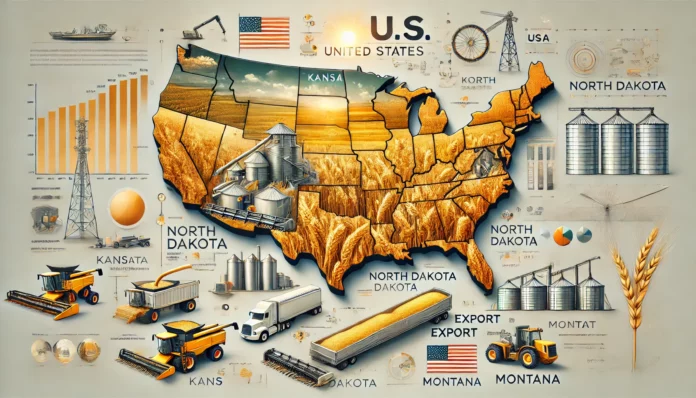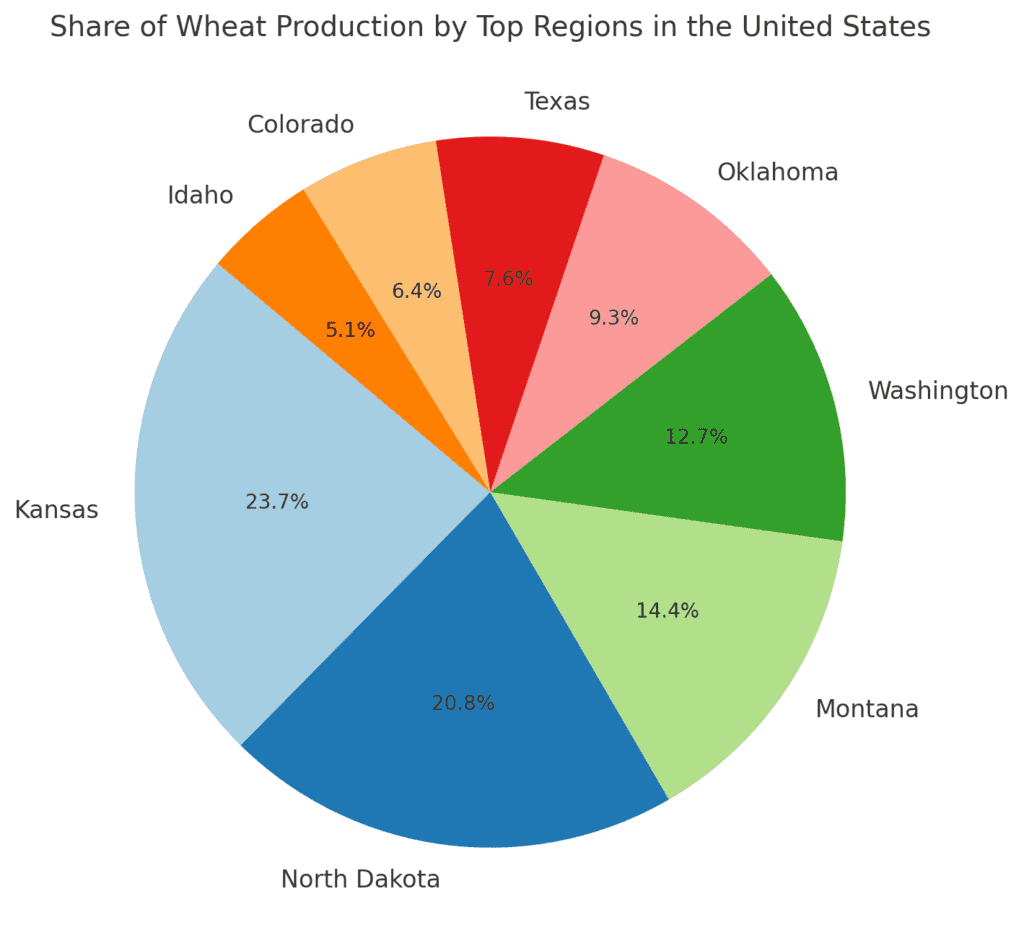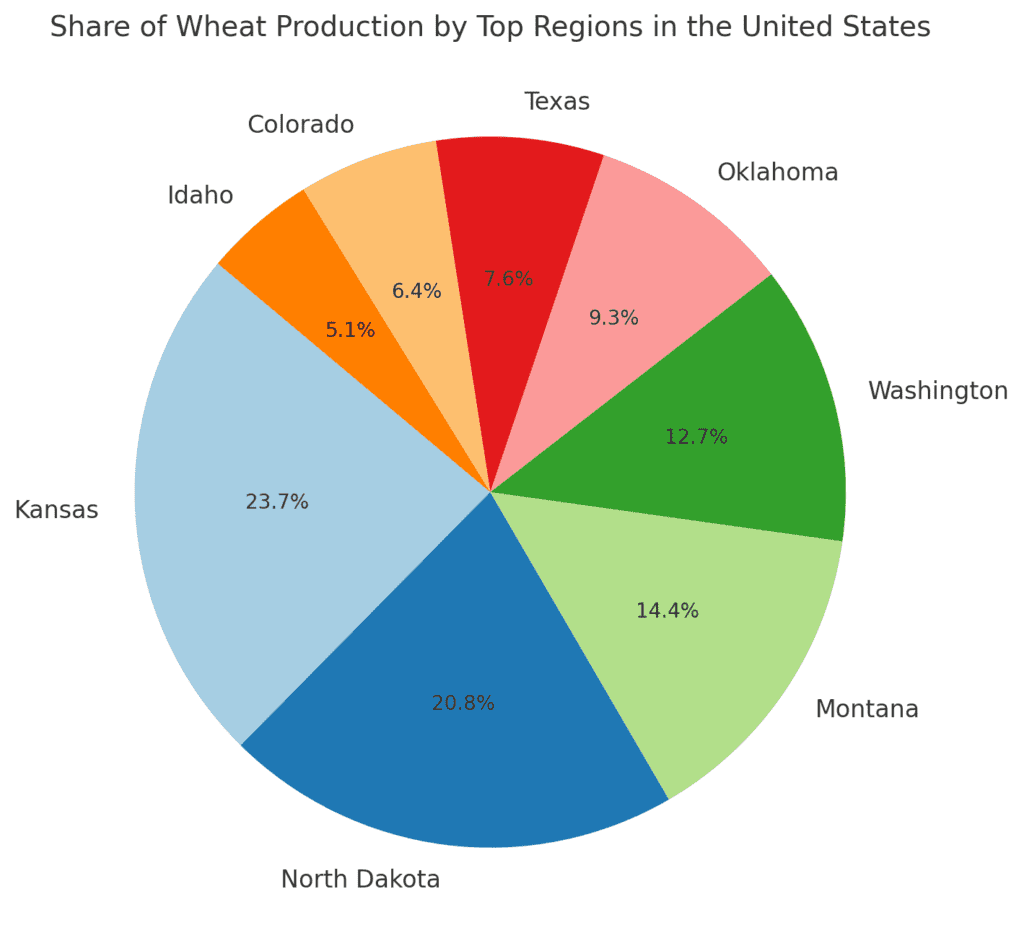
Wheat plays a critical role in the U.S. agricultural economy, serving as a staple crop and a key export commodity. With diverse climates and soil types, the United States produces several wheat varieties, from hard red winter wheat to soft white wheat, catering to both domestic and global markets. This article delves into the largest wheat-producing regions in the U.S., their contributions, and the advancements driving their agricultural success.

1. Kansas: The Wheat State
Kansas is the top wheat-producing state in the United States, often referred to as the “Wheat State.”
- Annual Production: Approximately 280 million bushels.
- Key Areas: Central and western Kansas, including Wichita, Salina, and Hays.
- Wheat Varieties: Primarily hard red winter wheat.
- Innovations: Utilizes no-till farming, GPS-guided tractors, and high-yield seed varieties.
- Significance: Kansas accounts for nearly 20% of the total U.S. wheat production, with much of it exported globally.
2. North Dakota: Leading in Durum Wheat
North Dakota specializes in producing high-quality durum wheat, used primarily for pasta production.
- Annual Production: Around 245 million bushels.
- Key Areas: Fargo, Grand Forks, and Bismarck regions.
- Wheat Varieties: Durum wheat and hard red spring wheat.
- Innovations: Precision agriculture, drone monitoring, and advanced irrigation systems.
- Significance: Supplies premium wheat for both domestic use and international markets.
3. Montana: A Major Player in Wheat Exports
Montana is a top wheat-producing state known for its high-quality hard red spring and durum wheat.
- Annual Production: Approximately 170 million bushels.
- Key Areas: Great Falls, Billings, and Havre.
- Wheat Varieties: Hard red spring wheat and durum wheat.
- Innovations: Focuses on sustainable practices and soil health improvement.
- Significance: A significant contributor to U.S. wheat exports.
4. Washington: Dominating Soft White Wheat Production
Washington is a leader in producing soft white wheat, used in pastries, cakes, and noodles.
- Annual Production: Around 150 million bushels.
- Key Areas: Palouse region, including Pullman and Spokane.
- Wheat Varieties: Soft white wheat.
- Innovations: Emphasizes water-efficient farming and organic wheat production.
- Significance: Most of Washington’s wheat is exported to Asian markets.
5. Oklahoma: A Strong Winter Wheat Producer
Oklahoma is a key producer of hard red winter wheat, thriving in its semi-arid climate.
- Annual Production: Approximately 110 million bushels.
- Key Areas: Enid, Lawton, and Woodward.
- Wheat Varieties: Hard red winter wheat.
- Innovations: Integrates crop rotation and drought-resistant varieties.
- Significance: Contributes significantly to the regional economy and national supply.
6. Texas: Wheat in the Lone Star State
Texas produces a considerable amount of wheat, mainly in the Panhandle and High Plains regions.
- Annual Production: Around 90 million bushels.
- Key Areas: Amarillo, Lubbock, and Wichita Falls.
- Wheat Varieties: Hard red winter wheat.
- Innovations: Employs advanced irrigation and pest management techniques.
- Significance: Supports the livestock industry by supplying feed wheat.
7. Colorado: A Growing Wheat Producer
Colorado is an emerging wheat producer, focusing on high-quality hard red winter wheat.
- Annual Production: Approximately 75 million bushels.
- Key Areas: Eastern Colorado, including Greeley and Fort Morgan.
- Wheat Varieties: Hard red winter wheat.
- Innovations: Incorporates sustainable water usage and precision farming.
- Significance: Supplies wheat for milling and export markets.
8. Idaho: A Small but Significant Producer
Idaho produces wheat primarily for specialty markets, including organic and non-GMO wheat.
- Annual Production: Around 60 million bushels.
- Key Areas: Boise, Twin Falls, and Idaho Falls.
- Wheat Varieties: Soft white wheat and hard red spring wheat.
- Innovations: Emphasizes environmentally friendly farming practices.
- Significance: Most wheat is exported to Asian and Middle Eastern countries.

Innovations in U.S. Wheat Production
The United States is a leader in agricultural innovation, which helps maintain its position as a top wheat producer:
- Precision Agriculture: Utilizes GPS, drones, and data analytics to optimize yields.
- Sustainability: Focus on crop rotation, soil health, and water conservation.
- Advanced Seeds: Development of pest-resistant and drought-tolerant wheat varieties.
- Efficient Logistics: Robust transportation and storage networks for export markets.
Challenges in U.S. Wheat Production
Despite its strengths, the U.S. wheat industry faces challenges:
- Climate Change: Unpredictable weather affects yields and quality.
- Global Competition: Rising production in countries like Russia and Canada.
- Declining Acreage: Farmers shifting to more profitable crops like corn and soybeans.
Conclusion
The largest wheat-producing regions in the United States, including Kansas, North Dakota, and Montana, are critical to the nation’s agricultural economy and global food supply. By adopting advanced technologies and sustainable practices, these regions ensure high-quality wheat production for both domestic and international markets.



